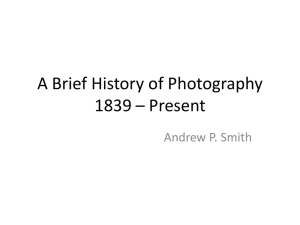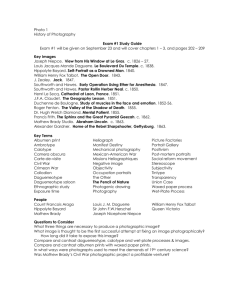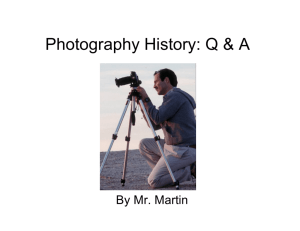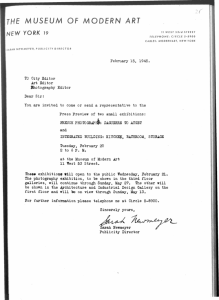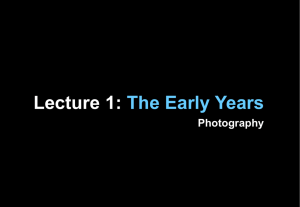Louis Jacques Mande DAGUERRE
advertisement
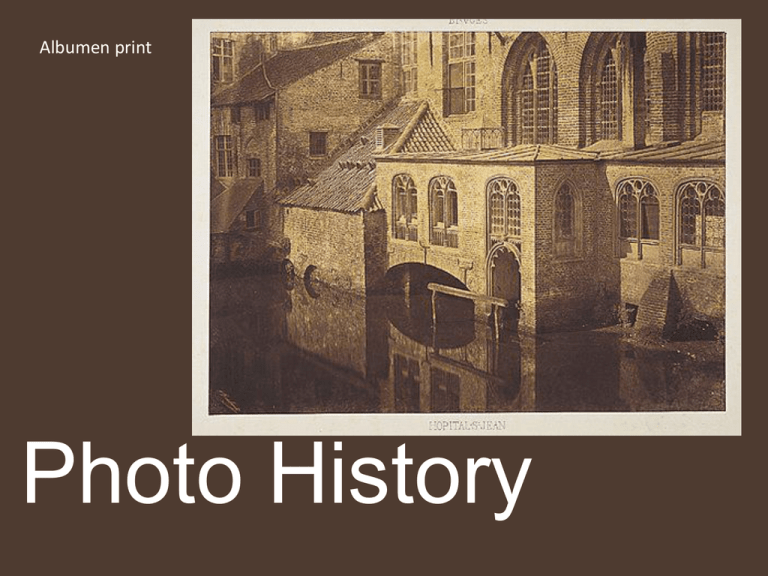
Albumen print Photo History Daguerrotype On 7 January 1839 Louis Jacques Daguerre announced to the French Academy of Sciences, his invention. Louis Jacques Mande DAGUERRE (1787-1851) The daguerreotype process was the first practicable method of obtaining permanent images with a camera. The man who gave his name to the process and perfected the method of producing direct positive images on a silver-coated copper plate was Louis Jacques Mande Daguerre, a French artist and scenic painter. Daguerre had began experimenting with ways of fixing the images formed by the camera obscura around 1824, but in 1829 he entered into partnership with Joseph Nicephore Niepce (1765-1833), a French amateur scientist and inventor who, in 1826, had succeeded in securing a picture of the view from his window by using a camera obscura and a pewter plate coated with bitumen. Niepce called his picture-making process heliography ("sun drawing"), but although he had managed to produce a permanent image using a camera, the exposure time was around 8 hours. Niepce later abandoned pewter plates in favor of silver-plated sheets of copper and discovered that the vapor from iodine reacted with the silver coating to produce silver iodide, a light sensitive compound. Boulevard du Temple, Paris, Spring 1838, by Daguerre (includes the earliest reliably dated photograph of a person). The image shows a busy street, but because the exposure time was at least ten minutes the moving traffic cannot be seen. However, two men at lower left, one apparently having his boots polished and the other the bootblack, remained motionless enough to be distinctly visible. The image is reversed (as were most Daguerreotypes) as is evidenced by the signage on a building in upper left. Daguerreotype camera built by La Maison Susse Frères in 1839, with a lens by Charles Chevalier. In 1848, Charles Fontayne and William Porter produced one of the most famous photographs in the history of the medium — a panorama spanning some 2 miles of Cincinnati waterfront. They did it with eight 6.5- by 8.5-inch daguerreotype plates, a then-new technology that in skilled hands displays mind-blowing resolution. Fontayne and Porter were definitely skilled, but no one knew just how amazing their images were until three years ago, when conservators at George Eastman House in Rochester, New York, began restoration work on the deteriorating plates. Magnifying glasses didn’t exhaust their detail; neither did an ultrasharp macro lens. Finally, the conservators deployed a stero microscope. What they saw astonished them: The details — down to window curtains and wheel spokes — remained crisp even at 30X magnification. The panorama could be blown up to 170 by 20 feet without losing clarity; a digicam would have to record 140,000 megapixels per shot to match that. Under the microscope, the plates revealed a vanished world, the earliest known record of an urbanizing America. But the conservators also found trouble. At that magnification, dust motes smaller than red blood cells became image-obscuring blobs. Corrosion from a few molecules of water obscured a face peeking out a window. Even polishing marks from the original preparation of the plates became a mass of dark streaks. Trying to restore the plates themselves might have damaged the images, and the conservators didn’t want to risk ruining the finest American daguerreotypes in existence. So they put them in a case filled with inert argon gas to arrest the deterioration and went digital, turning to computer vision specialists at the University of Rochester. To them, the images were just noisy data, which they knew how to scrub. http://www.wired.com/magazine/2010/07/ff_daguerrotype_panorama/ • The daguerreotype was made on a highly polished surface of silver that was plated on a copper sheet. • It was sensitized by being placed (silver side down) over a container of iodine crystals inside a box. Rising vapor reacted with the silver, producing the light-sensitive compound silver iodide. • During exposure, the plate recorded a latent image (a chemical change had taken place, but no evidence of it was visible.) • To develop the image the plate was placed, silver side down, in another box containing a dish of heated mercury at the bottom. • Vapor from the mercury reacted with the exposed areas of the plate. Where ever light had struck the plate, mercury formed a frostlike amalgam with the silver. • This amalgam made up the bright areas of the image. • Where no light had struck, no amalgam was formed; the unchanged silver iodide was dissolved in sodium thiosulfate fixer, leaving the bare metal plate, which looked black, to form the dark areas of the picture. How long were the average exposures for these images? • 1839 Daguerreotype half-plate & whole plate 15-30 minutes • 1841 Daguerreotype ninth-plate & sixth- plate 20 sec - 90 seconds • 1842 Daguerreotype ninth-plate & sixth- plate 10 sec - 60 seconds Robert Louis Stevenson List three attributes of the Daguerreotype. • Fidelity of the image (fine details). • Can last forever if properly cared for • Excellent for portraits List three disadvantages of the Daguerreotype. • Difficulty in viewing – had to be held at certain angles. • Mercury vapor highly poisonous • Plate (image) was unique – no negative for reproduction. Calotype Who invented the Calotype? • Henry Fox Talbot Where and when was it invented? •Lacock Abby, England, 25 January 1839; three weeks after Daguerre Henry Fox Talbot Lacock Abbey, first window shot (below) from the inside looking out and today, from the outside. Harry Potter’s school. Lacock Abbey was used for the Hogwarts school in the Harry Potter movies. What was the process? Negative paper/sensitized for the camera/development and print: • The first stage in producing the negative paper was to iodize the paper. This was done by brushing silver-nitrate solution onto one side of a sheet of fine quality writing paper and drying it. Then in the dark, the paper was immersed in a potassium iodide solution and left to dry in the sunlight. • The second stage was to sensitize the paper for the camera. The paper was coated with silver-nitrate and gallic acid, thus making it light-sensitive. It was left to sit for about thirty seconds and then dipped in water. It was then partially dried in the dark, often using blotting paper and was loaded damp into the camera. After an exposure of up to ten minutes, depending on the weather, time of day and intensity of the chemicals used, a latent image was formed. • To develop the image, the paper was again dipped in a bath of silver-nitrate, acetic and gallic acids, and washed over with a fixing liquid such as bromide of potassium. Strictly speaking, the term calotype applied only to the negative – the positive prints were made by placing the negative on top of sensitized salted paper. This was then laid flat in a frame and exposed to daylight until a positive image appeared. Positive Image Negative image. List 3 advantages of the Calotype over the Daguerreotype. • Reproducible image – negative from which copies could be made. • Fibers of paper produced a soft, slightly textured image – more like a charcoal drawing • The calotype had warmer tones and was more durable than the daguerreotype, which was easily damaged by touching List 2 disadvantages of the Calotype. • Lacked the sharp detail of the Dagerreotype. • The calotype had a tendency to fade and could also be quite blurred because of imperfections in the paper. • The materials the calotype used were less sensitive to light than those of the daguerreotype, adding more time to the already lengthy process. The Pencil of Nature, written by Henry Fox Talbot, was published in six installments between 1844 and 1846, and was the "first photographically illustrated book to be commercially published”. It was wholly executed by the new art of Photogenic Drawing, without any aid whatever from the artist's pencil and regarded as an important and influential work in the history of photography. The book detailed Talbot's development of the calotype process and included 24 calotype prints, each one pasted in by hand, illustrating some of the possible applications of the new technology. Since photography was still very much a novelty, Talbot felt compelled to insert the following notice into his book: The plates of the present work are impressed by the agency of Light alone, without any aid whatever from the artist's pencil. They are the sun-pictures themselves, and not, as some persons have imagined, engravings in imitation. Albumen Prints & Cartes de Visite Carte de Visite photographs-small albumen prints mounted on cards 2-1/2 by 4 inches--were wildly popular and made for decades in countries around the world. The format was an international standard; for the first time, relatives and friends could exchange portraits, knowing they would find a place in the recipient's family album-whether that album was located in Brooklyn, Berlin or Brazil Unlike earlier photographs made with such processes as the daguerreotype and ambrotype, cartes de visite could be sent through the mail without the need for a bulky case and fragile coverglass. Their small size also made them relatively inexpensive, and they became so widespread that by 1863 Dr. Oliver Wendell Holmes would write, "Card portraits, as everybody knows, have become the social currency, the 'greenbacks' of civilization.” British photographer Julia Margaret Cameron brought her bulky camera close to her sitters, capturing their portraits on large plates (approximately 11 x 14 in.). Cameron often wrote below these life-size prints, “From Life Not Enlarged.” She was known for capturing the psychological and intellectual qualities of her sitters. When making this portrait of Sir John F. W. Herschel, Cameron encouraged the famed astronomer to move during the exposure, blurring the finished print. She thought this might visually evoke his reputation for innovation. Julia Margaret Cameron (England, 1815–1879) Sir John F. W. Herschel. 1867 Albumen print 14 x 10 3/4 in. image size English author and photographer Charles Lutwidge Dodgson was a photographic artist and a prominent member of Victorian society. Dodgson (better known by his pen name, Lewis Carroll) made studies of children, landscapes, sculpture, skeletons, and animals. His close relationship with the Liddell family is recorded in photographs he made of them. This albumen print pictures Lorina Liddell, whose younger sister Alice Liddell is alleged to be the young girl immortalized in Dodgson’s/Carroll’s masterpiece, Alice’s Adventures in Wonderland. Charles Lutwidge [Lewis Carroll] Dodgson (England, 1832–1898) Lorina Liddell with Black Doll. 1858 Albumen print 5 1/8 x 4 1/8 in. image size Samuel Bourne (England, 1834–1912) Avenue of the Poplars at Srinagar (Srinagar, India). 1869 Albumen print 9 1/2 x 11 3/4 in. image size. British photographer Samuel Bourne was interested in visiting foreign places and capturing picturesque images of the unfamiliar. In 1863 Bourne traveled to British-controlled India. In this albumen print, his subject is a neat phalanx of trees retreating in orderly fashion toward a vanishing point. A Victorian appreciation of orderly spatial relationships is manifested in Bourne’s rational approach to composition. This albumen print pictures the Pantheon in Paris, a monument that prolific French photographer Édouard-Denis Baldus returned to photograph repeatedly over the course of his career. Baldus cultivated a photographic style that allowed nothing to detract from the essence of his architectural subjects. In this print, he frames the building so that nothing draws the viewer’s attention from the weighty presence of its façade. Édouard-Denis Baldus (France, b. Prussia, 1813–1889) Panthéon [from Vues de Paris en Photographie, no. 32]. 1858 Albumen print 10 5/16 x 7 7/8 in. image size Collodion Wet-Plate Frederick Scott Archer invented the process in 1851 Frederick Scott Archer (1813–1 May 1857) In 1851 Frederick Scott Archer published details of the wet collodion process, this produced a grainless glass negative capable of making beautifully sharp prints, on salt or albumen paper, and it dominated photography for the next thirty years, that is until the introduction of the dry plate in the 1880s. In 1851 Frederick Scott Archer published details of the wet collodion process, this produced a grainless glass negative capable of making beautifully sharp prints, on salt or albumen paper, and it dominated photography for the next thirty years, that is until the introduction of the dry plate in the 1880s. An under exposed negative backed partly by white paper and partly by black paper. The lower left half is clearly seen as a positive image while the upper right half is also clearly seen to be an under exposed negative. During the 1850s an ingenious American conceived the idea that rather than using a black backed glass plate as a support for a positive image, by substituting instead a thin shiny black lacquered iron sheet as a support, an even cheaper and much more robust product could be produced. This became known as the Ferrotype, from one of the early trade names. Like the ambrotype, the positive image was produced by making an under exposed negative on a shiny black background. The slang name Tintype was often used for the Ferrotype. Ferrotypes and Ambrotypes both are, like Daguerrotypes, one off processes and the Ferrotype shares the Daguerrotype’s lateral reversal or mirror image effect. Despite this drawback the Ferrotype’s victory over the ambroype was complete by the middle 1860s and the ambrotype quickly followed the Daguerrotype into oblivion. There are several reasons for this, apart from the cheapness of the product. The Ferrotype, because it is only a very thin piece of steel sheet was easily mounted in albums unlike the glass ambrotype, also for the same reason it could be slipped into an envelope and posted quite safely What was the process? Plate/Exposure/development/fixing • Glass plate coated with collodion (nitrocellulose dissolved in ether and alcohol). • Mixture of collodion and potassium iodiode poured onto glass and the plate tilted from side to side to spread the mixture. (Remainder poured back into its container.) • Then the plate was sensitized by being dipped in a bath of silver nitrate. • Exposed for a latent image while still damp, then developed in pyrogallic acid or iron sulfate, fixed, washed and dried Ambrotype Collodion coated on glass produced a negative from which a positive could be printed on what type of paper? Albumen-coated paper. If the glass negative was backed with a dark material like black velvet, paper or paint, the image was transformed into a positive or ambrotype. What were the advantages of this process over the Daguerreotype or Calotype? It had the sharpness of a Daguerreotype and the reproducibility of the Calotype. It was more light sensitive then either of them with exposures as short as five seconds. What was the biggest disadvantage of the Collodian process? • The plate had to be exposed and processed while it was still wet. That meant that the photographer had to travel with a darkroom! A photographer from that era described a typical load that someone might carry: • 9 x 11” brass-bound camera weighing 21 pounds • A water-tight glass bath in a wooden case holding over 90 ozs. Of solution (nitrate of silver) weighing 12 lbs. • A plate box with a dozen 9 x 11” plates weighing almost 12 lbs. • A box 24 x 18 x 12” into which werep packed lenses, chemicals and all the hundred-and-one articles necessary for a hard day’s work, and weighing about 28 lbs. • A tripod (over 5 feet in length) and weighing about 5 pounds. • A 40 x 40” tent that was used for the darkroom; standing 6.5 feet high with ample table accommodation. The whole thing packed into a leather case and weighs about 40 pounds. The whole load is about 120 pounds! Define Ambrotype A collodion wet-plate process in which the emulsion was coated on a glass plate. The negative image produced was visible as a positive image when the glass was backed with a dark material. What does Ambrotype mean in Greek? Ambrotype - from the greek word Ambro meaning imperishable. What does Calotype mean in Greek? Calotype means beautiful impression after the Greek Kalos and typos. Define Tintype A historic collodion wet-plate process in which the emulsion is coated onto a dark metal plate. It produces a direct positive image. What was one of the most popular uses for Collodion prints? (used as entertainment) Stereographic photographs. If two photographs are taken side by side to emulate what are eyes see, they can then be viewed through a stereoscope which gives the impression of a 3-D image. Between the 1840s and the 1920s, stereographs served as an important method of entertainment, education, and virtual travel—predecessors to contemporary forms of media such as television and movies. Why were Ambrotypes often kept in a frame within a protective case? Ambrotypes were made of glass and easily damaged. Cyanotype What is a cyanotype? Cyanotype is a photographic printing process that gives a cyanblue print. The process was popular in engineering circles well into the 20th century. The simple and low-cost process enabled them to produce large-scale copies of their work, referred to as blueprints. Two chemicals are used in the process: • Ammonium iron (III) citrate • Potassium ferricyanide. Who invented the cyanotype? What was the year? The English scientist and astronomer Sir John Herschel discovered this procedure in 1842 Who was the first person to use the cyanotype process to photographically illustrate a book using cyanotypes? A photogram of Algae, made by Anna Atkins as part of her 1843 book, Photographs of British Algae: Cyanotype Impressions, the first book composed entirely of photographic images. "Sir John Herschel, invented the cyanotype photographic process in 1842. Atkins applied the process to algae by making cyanotype photograms that were contact printed by placing the unmounted dried-algae directly onto cyanotype paper." Photographs of British Algae: Cyanotype Impressions - 1843 Anna Atkins Anna Atkins, an English botanist and photographer, the reason this process was used in photography. Atkins being a friend of Herschel, took his newly discovered process and applied it to her seaweed collection. She began making contact prints by placing the objects directly onto the coated paper and then exposing them to light, creating a silhouette effect. By using this process, Atkins became the first ever female photographer Blue Print of Auditorium Cyanotype Prints Type: Box rollfilm Introduced: Feb 1900 Discontinued: Oct 1901 Film size: 117 Picture size: 2 1/4 X 2 1/4" Manufactured: US Lens: Meniscus Shutter: Rotary Numbers made: 245,000 Original price: $1.00 Description: Leatherette covered Card box with a wooden film carrier no finder but V sighting lines on top clip-on accessory reflecting finder available from August 1900 detachable film winding key This camera introduced the 2 1/4" square format Fun Facts: This camera is considered by many experts to be the most important camera ever manufactured. The reason is that it was produced so cheaply that anyone, not just professionals or people of means, could own it. Because it was so simple to use, anyone could operate it right out of the box. The film was also cheap, even for 1900. For less than $2.00 anyone could buy The Brownie, a roll of film, and get it processed. The February 1900 Trade Circular lists a 6 exposure roll of transparent film at $0.15, paper-negative film at $0.10, and $0.40 for processing them! The Brownie also showed the marketing genius of George Eastman. Eastman was first a film manufacturer, but he could see what bringing photography to the masses, especially marketing to young people, via cheap but durable cameras would mean for future film sales and processing. A camera in every home meant alot of film to be sold and processed. He could not have been more correct! The first Brownie camera was shipped on Feb. 8, 1900 and gave birth to the snapshot. Type: Self-erecting folding rollfim Introduced: 1948 Discontinued: 1954 Film size: 620 Picture size: 2 1/4 X 3 1/4" Manufactured: UK Lenses: Meniscus fixed focus Anaston f/6.3, 100mm focusing Shutters: Kodette II (Meniscus lens and shutter release cable capable) Dakon (Anaston lens) with bayonet flash contacts Numbers made: Well over 300,000 Original price: ? Description: Morocco grained imitaion leather covering; folding optical frame finder; except for the optical frame finder the meniscus lens model is essentially the same as the pre-war version (Six-20 Folding Brownie). 1915 AD Kodak Kodak is the most famous name in cameras. This is the No.2 Folding Brownie Autograph Camera. It is easy to use and was very popular. Before Kodak came along taking photographs was quite difficult. Kodak cameras used film. Photographers could send their films off or put them into chemist shops to be developed. A photographer needed no knowledge of chemistry. Being easy, families took many photographs of holidays, children playing, weddings and so on Kodak Reflex Camera The Kodak Reflex camera was manufactured by the Eastman Kodak company from 1946 to 1949. A good quality, medium format, twin lens camera. The Kodak Reflex was fitted with a Kodak f3.5 lens in a flash Kodamatic shutter capable of providing speeds from 1/2 to 1/200 of a second second, plus Bulb and Time settings. Originally priced at $100.00. Wet Plate Camera
